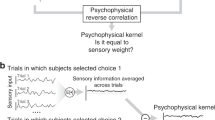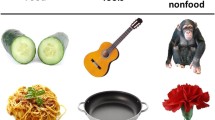Abstract
Taste cognition can be interfered with by visual information, but the mechanism by which this happens has not been clarified. We assumed an interference model in the processes of taste and vision information. The model was tested with frequency analysis on EEG and using the switch response time. The tasks were matched/miss-matched between taste and vision information about orange juice and apple juice. There were changes in the α waves that originated in the visual processing of a juice package, and changes in the β waves that originated in the taste processing. There is the possibility of a parallel processing mechanism in the vision-taste interference.
Similar content being viewed by others
Explore related subjects
Discover the latest articles, news and stories from top researchers in related subjects.References
Okumura M, Kato K, Yamamoto K (2008) Study on change of facial expression with taste stimulation. Institute of Image Information and Television Engineers Technical Report 32(35):53–56
Furuichi T, Nozawa A, Ide H (2006) Comparison between amount of gustatory sense and nasal skin temperature. IEICE Technical Report MBE 2006-50
Kiyota H, Morita K, Murayama N (1999) Evoked potential to gustatory stimuli in man. Technical Report of IEICE MBE 98-120
Uematsu H, Hirata K, Morino H, et al (2004) Analysis of emotional response to visual stimulation with β wave mapping. IEICE Technical Research Report MBE 103(637):65–70
Sato Y, Tanaka H (2009) Measurement of spontaneous brain waves to develop taste processing model. Institute of Electrical Engineers of Japan Research Report
Author information
Authors and Affiliations
Corresponding author
Additional information
This work was presented in part at the 16th International Symposium on Artificial Life and Robotics, Oita, Japan, January 27–29, 2011
About this article
Cite this article
Tanaka, H., Sato, Y. A vision-taste interference model and the EEG measurement. Artif Life Robotics 16, 393–397 (2011). https://doi.org/10.1007/s10015-011-0958-0
Received:
Accepted:
Published:
Issue Date:
DOI: https://doi.org/10.1007/s10015-011-0958-0




